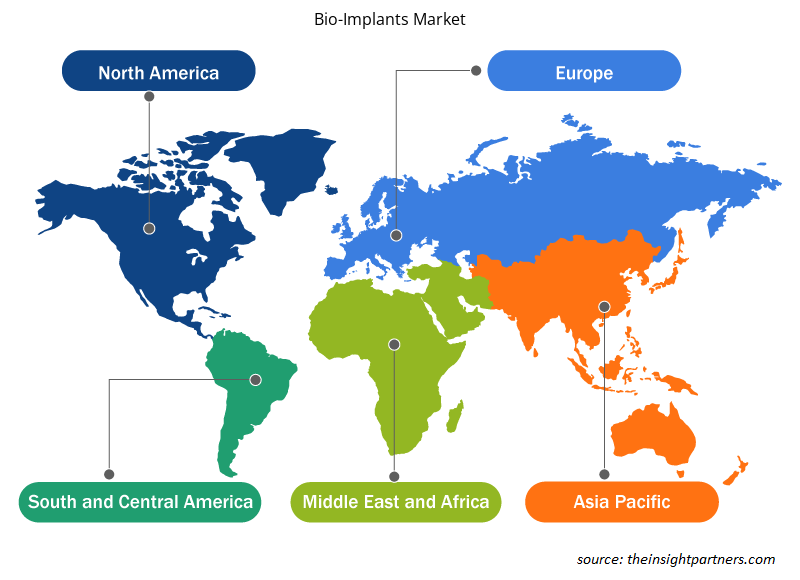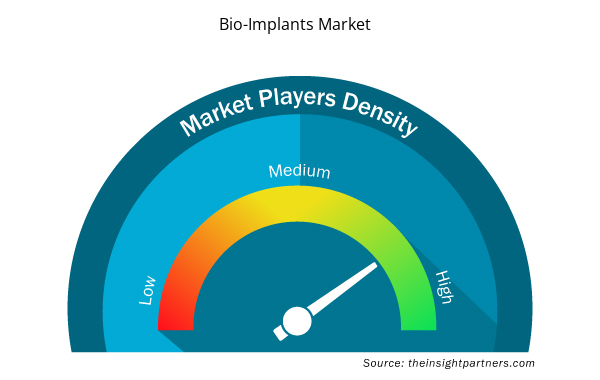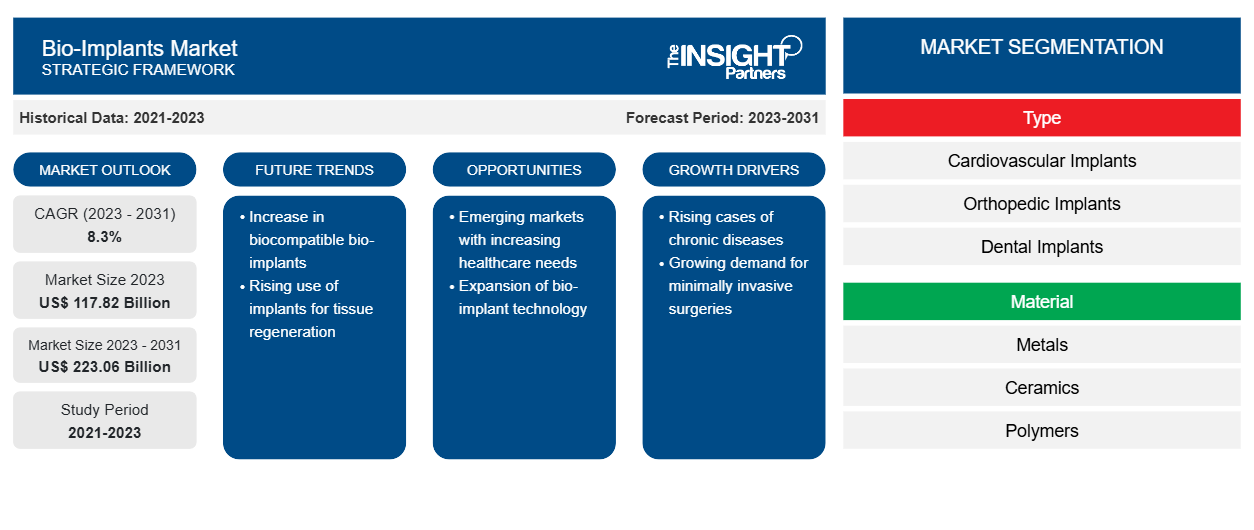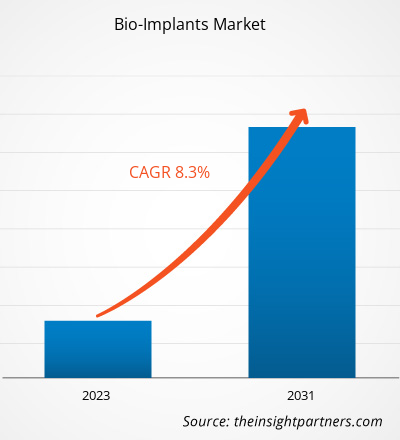[調査レポート] バイオインプラント市場は2023年に1,178.2億米ドルと評価され、2031年までに2,230.6億米ドルに達すると予測されています。市場は2023年から2031年の間に8.3%のCAGRを記録すると予測されています。
アナリストの視点:
このレポートには、現在のバイオインプラント市場の動向とバイオインプラント市場の成長に影響を与える推進要因を踏まえた成長見通しが含まれています。バイオインプラント市場規模の拡大に寄与する主な要因には、特に高齢者人口における慢性疾患の増加と可処分所得の増加があります。先進国と発展途上国の医療インフラはさらに改善すると予想されており、バイオインプラント市場を大きく牽引します。
美容インプラントの有効性と技術の進歩に関する認識は、世界中の人々の間で高まっています。バイオインプラントの市場は、歯科疾患の増加により世界中で成長しています。心血管系および整形外科疾患の発生率の上昇により、整形外科用インプラントとペースメーカーの需要も増加しています。北米でのバイオインプラントコントロールの全体的な売上は、強力な医療インフラ、美容インプラントの認識の高まり、およびこの地域のバイオインプラント市場の主要プレーヤーにより、増加すると予想されています。さらに、ヨーロッパは、医療における急速な技術進歩、非侵襲性バイオインプラントの需要の増加、および高齢者人口の急増により、世界で2番目に大きなバイオインプラント市場です。ただし、バイオインプラント手順のコストの上昇とバイオインプラント製品の適切な利用は、バイオインプラント市場の成長を妨げています。
市場概要:
バイオインプラント市場の成長に寄与する主な要因としては、高齢者の骨の弱化の増加、低侵襲手術の需要の増加、生活習慣病の増加などが挙げられます。さらに、ヘルスケアにおける技術開発は、今後数年間のバイオインプラント市場の予測に大きな影響を与えると予想されています。ヘルスケア部門は長年にわたって大きな技術的進歩を遂げてきましたが、深刻な医学的疾患の発生率の上昇がバイオインプラント市場の妨げとなっています。
要件に合わせてレポートをカスタマイズする
このレポートの一部、国レベルの分析、Excelデータパックなど、あらゆるレポートを無料でカスタマイズできます。また、スタートアップや大学向けのお得なオファーや割引もご利用いただけます。
- このレポートの主要な市場動向を入手してください。この無料サンプルには、市場動向から見積もりや予測に至るまでのデータ分析が含まれます。
市場の推進要因:
生活習慣病の負担増加が市場の成長を促進
糖尿病、心血管疾患、変形性関節症などの生活習慣病は、世界中でますます蔓延しており、罹患率と死亡率の主な原因となっています。ステントやスキャフォールドなどのバイオインプラントは、これらの症状を治療することができ、従来の永久インプラントの魅力的な代替品になりつつあります。2021年に米国心臓協会が発表した記事によると、米国では毎年約4万人の子供が先天性心疾患の手術を受けています。2022年に英国心臓財団が発表した「2022年1月の英国ファクトシート」には、2021年に約760万人が心臓および循環器疾患を患っており、男性約400万人と女性360万人が心臓病および循環器疾患を患っていると記載されています。したがって、心血管疾患の罹患率の増加は、早期診断と治療の必要性の高まりにつながり、インターベンション心臓学手順や心血管インプラントバイオインプラントの需要が高まると予想されます。さらに、口腔衛生問題の急増により、バイオインプラントの需要が増加すると予想されています。たとえば、世界保健機関(WHO)の2021年世界疾病負担調査によると、口腔疾患は世界人口の約半数に影響を与えると予想されています。約35億8千万人が虫歯やその他の歯科疾患に悩まされています。バイオインプラント
さらに、バイオインプラントは、筋骨格障害などの症状における特定の薬物送達の管理と制御に役立ちます。2021年1月に整形外科で発表された記事によると、北京コミュニティの中年層における腰椎すべり症の全体的な有病率は17.26%(男性15.98%、女性18.80%)でした。60歳以上の女性は腰椎すべり症に苦しむ可能性が高くなります。WHOによると、筋骨格系の傷害や疾患は広範囲に広がっており、世界中で17億1000万人に影響を与えており、世界中の障害の主な原因となっています。ランセットリウマチ学に掲載された新しい研究によると、2020年の約5億人から2050年までに10億人以上が関節、筋肉、骨、靭帯、腱、脊椎の疾患に苦しむと予想されています。高齢化が進むにつれ、筋骨格系の疾患やそれに伴う機能障害を抱える人の数が急増しています。患者の間で筋骨格系の疾患が増えると、インプラント手術や入院の需要が増加し、バイオインプラント市場が成長します。
セグメント分析:
バイオインプラント市場の分析は、タイプ、材料、エンドユーザーというセグメントを考慮して実施されました。
タイプに基づいて、バイオインプラント市場は、心血管インプラント、整形外科インプラント、歯科インプラント、眼科インプラント、その他に分類されます。心血管インプラントセグメントは、2023年に大きな市場シェアを占めました。このセグメントの成長は、新しい心臓インプラント製品を開発するための研究開発活動の急速な増加によるものです。たとえば、2022年2月、医療技術会社のアボットは、AVEIR DR i2iピボタル臨床試験の一環として、世界初のリードレスデュアルチャンバーペースメーカーシステムの患者への植え込みを発表しました。アボットの実験的なデュアルチャンバーリードレスペースメーカーの植え込みは、リードレスペースメーカー技術にとって重要な技術的マイルストーンであり、ピボタル試験の対象となるのは世界初です。
バイオインプラント市場は、材料に基づいて、金属、セラミック、ポリマーに分類されます。即時放出カプセルセグメントは、2023年に最大の市場シェアを占めました。さらに、予測期間中に最高のCAGRを記録すると予想されています。これらの金属は、その優れた機械的強度、耐腐食性、生体適合性により、インプラント用途に最適です。チタンは、その並外れた耐久性、軽量設計、および人体組織との適合性により、整形外科、歯科、および心血管インプラントの非常に人気のある材料です。金属は、その展性、導電性、および不活性のため、心臓電極や神経プローブなどの特殊なインプラント用途での使用に高く評価されています。慢性疾患の発生率の増加と材料科学および製造技術の改善により、バイオインプラントにおけるバイオマテリアル金属の需要が高まっています。これにより、バイオインプラント市場で最も人気のある材料カテゴリとしてのバイオマテリアル金属の地位が確固たるものになりました。
エンドユーザーに基づいて、市場は病院と診療所と外来手術センターに分かれています。病院と診療所のセグメントは2023年にバイオインプラントの市場シェアを拡大し、2023年から2031年にかけてより高いCAGRを記録すると予想されています。病院と診療所は、広範な医療プログラムと患者ケアに対する多分野にわたるアプローチにより、専門的なインプラント治療を必要とする患者を含む大規模な患者ベースを引き付けることがよくあります。病院は通常、研究センターや医療機器メーカーと提携して、最先端のインプラントのブレークスルーとテクノロジーへのアクセスを容易にします。病院と診療所は、必要なインプラント関連サービスを提供し、バイオインプラントに関連する商品とプロセスに対する大きな需要を生み出すため、バイオインプラント市場の重要なプレーヤーです。したがって、人々の間で医薬品の需要が急増している病院と診療所の数の増加は、予測期間中に市場におけるこのセグメントの成長をサポートすると予想されます。
地域分析:
バイオインプラント市場レポートの対象範囲には、北米、ヨーロッパ、アジア太平洋、中東およびアフリカ、南米および中米が含まれます。北米の市場は2023年に505億1,000万米ドルと評価され、2031年までに966億9,000万米ドルに達すると予測されています。2023年から2031年の間に8.5%のCAGRを記録すると予想されています。北米市場は、米国、カナダ、メキシコに分割されています。北米での市場成長は、慢性疾患の有病率の増加と医療インフラの改善に起因しています。2022年7月に更新された米国疾病管理予防センター(CDC)のデータによると、冠動脈疾患は最も一般的なタイプの心臓病の1つであり、米国では20歳以上の成人約2,010万人がこの疾患を抱えて生活しています。さらに、CDC のデータによると、40 秒ごとに 1 人が心臓発作を起こしており、その数は約 805,000 人です。慢性疾患の増加により、予測期間中にバイオインプラントの全体的な需要が増加すると予想されます。
メディケア・メディケイドサービスセンターによると、国の医療費は2028年までに6.2兆米ドルに達し、2019年から2028年まで平均年率(AAR)5.4%で増加すると予想されています。国の医療費は1.1%ポイント増加すると予想されており、経済に占める医療費の割合は2028年に19.7%増加すると予想されており、2019年から2028年の平均年間GDPよりも速いペースです。したがって、医療費の増加により、市場プレーヤーが予測期間中にバイオインプラントを開発する機会が生まれると予想されます。
ヨーロッパは、2023年にバイオインプラント市場で2番目に大きなシェアを占めています。この地域の市場成長は、ヘルスケアの技術的進歩、非外科的バイオインプラントの需要増加、および老年人口の増加に起因しています。ヨーロッパの市場成長は、ヘルスケアに対する政府の資金提供と支援、整形外科疾患の発生率の増加、およびヘルスケアにおける研究開発活動の増加に起因しています。さらに、この地域での心血管疾患の発生率の増加による心血管手術の数の増加が、この地域のバイオインプラント市場を牽引しています。
アジア太平洋地域は、2023年から2031年にかけて世界のバイオインプラント市場で最高のCAGRを記録すると予想されています。この地域の市場成長は、高齢者人口の増加、可処分所得の増加、医療投資の増加と市場プレーヤーによる拡大、交通事故の増加による脊髄損傷の増加に起因しています。アジア太平洋地域は、特に中国やインドなどの新興市場で著しい成長を遂げています。効率的な患者サービスを提供するための医療インフラの拡大とこの分野への投資の増加が、この地域のバイオインプラント市場を牽引しています。たとえば、日本の慶応大学の2019年の出版物によると、日本では約10万人の患者が脊髄損傷により麻痺しています。しかし、iPS技術の承認により、近い将来、国内のこれらの患者を助けることが期待されており、今後数年間でバイオインプラント市場にチャンスがもたらされる可能性があります。国連アジア経済社会委員会と太平洋社会開発局によれば、2016年時点でアジアの人口の12.4%以上が60歳以上であり、2050年末までにその数は13億人に達すると予想されている。
バイオインプラント
バイオインプラント市場の地域別分析
予測期間を通じてバイオインプラント市場に影響を与える地域的な傾向と要因は、Insight Partners のアナリストによって徹底的に説明されています。このセクションでは、北米、ヨーロッパ、アジア太平洋、中東、アフリカ、南米、中米にわたるバイオインプラント市場のセグメントと地理についても説明します。

- バイオインプラント市場の地域別データを入手
バイオインプラント市場レポートの範囲
| レポート属性 | 詳細 |
|---|---|
| 2023年の市場規模 | 1,178.2億米ドル |
| 2031年までの市場規模 | 2,230.6億米ドル |
| 世界のCAGR(2023年~2031年) | 8.3% |
| 履歴データ | 2021-2023 |
| 予測期間 | 2023-2031 |
| 対象セグメント | タイプ別
|
| 対象地域と国 | 北米
|
| 市場リーダーと主要企業プロフィール |
|
バイオインプラント市場のプレーヤー密度:ビジネスダイナミクスへの影響を理解する
バイオインプラント市場は、消費者の嗜好の変化、技術の進歩、製品の利点に対する認識の高まりなどの要因により、エンドユーザーの需要が高まり、急速に成長しています。需要が高まるにつれて、企業は提供を拡大し、消費者のニーズを満たすために革新し、新たなトレンドを活用し、市場の成長をさらに促進しています。
市場プレーヤー密度とは、特定の市場または業界内で活動している企業または会社の分布を指します。これは、特定の市場スペースに、その市場規模または総市場価値に対してどれだけの競合相手 (市場プレーヤー) が存在するかを示します。
バイオインプラント市場で事業を展開している主要企業は次のとおりです。
- ライフネットヘルス
- スミス・アンド・ネフュー
- アースレックス株式会社
- クリニック レマニック
- アルファバイオテック
免責事項:上記の企業は、特定の順序でランク付けされていません。

- バイオインプラント市場のトップキープレーヤーの概要を入手
主要プレーヤー分析:
LifeNet Health、Smith & Nephew、Arthrex, Inc.、Clinic Lemanic、Alpha Bio Tec、MiMedx Group、Medtronic、St Jude Medical (Abbott)、Stryker Cooperation、DePuy Synthes、Biomet (Zimmer)、Exactech, Inc.、Cochlear Ltd、およびStraumann AGは、バイオインプラント市場レポートで紹介されている主要企業の一部です。
最近の動向:
市場で事業を展開する企業は、合併や買収などを採用しています。各社のプレスリリースによると、最近の重要な動向は以下のとおりです。
- 2023年2月、湾曲した骨の骨折を修復するために設計された医療機器開発会社であるCurvaFix, Inc.は、直径7.5mmのより小さなCurvaFix IMインプラントの発売を発表しました。このインプラントは、外科手術を簡素化し、小さな骨に強力で安定した固定を提供するように設計されており、骨のある患者を支援することを目的としています。
- 2022年6月、ZimVieは米国食品医薬品局の認可を受けたT3プロエンジニアインプラントとEncode Emergence Healing Abutmentを米国で発売しました。
- 2021年6月、医療機器メーカーのIntelligent Implants Ltd.は、整形外科用インプラント技術であるSmartFuseに関して米国FDAから画期的な認可を取得しました。SmartFuseプラットフォームは、骨の成長を遠隔で刺激、制御、監視し、リアルタイムで臨床判断を下せるように設計されています。この製品は、腰椎固定術を受ける初回使用患者を対象としています。
- メドトロニックは、2021 年 2 月に、心臓埋め込み型電子機器または埋め込み型神経刺激装置を安定させるために設計された吸収性、使い捨て、抗菌性のシースである TYRX 吸収性抗菌シースを発売しました。
- 過去2年間の分析、基準年、CAGRによる予測(7年間)
- PEST分析とSWOT分析
- 市場規模価値/数量 - 世界、地域、国
- 業界と競争環境
- Excel データセット



Report Coverage
Revenue forecast, Company Analysis, Industry landscape, Growth factors, and Trends

Segment Covered
This text is related
to segments covered.

Regional Scope
North America, Europe, Asia Pacific, Middle East & Africa, South & Central America

Country Scope
This text is related
to country scope.
よくある質問
The bio implants market is expected to be valued at US$ 223.06 billion in 2031.
The global bio implants market, based on type, the bio implants market is segmented into cardiovascular implants, orthopedic implants, dental implants, ophthalmic implants, and others. The cardiovascular implants segment held the largest bio implants market share in 2023; it is also expected to register the highest CAGR during 2023–2031. The bio implants market, based on material, is segmented into metals, ceramics, and polymers. The metals segment held the largest bio implants market share in 2023. It is further expected to register the highest CAGR from 2023 to 2031. Based on end user, the market is bifurcated into hospitals & clinics and ambulatory surgical centers. The hospitals & clinics segment accounted for a larger market share in 2023. The same segment is anticipated to register a higher CAGR during 2023–2031.
The bio implants market majorly consists of the players such as LifeNet Health; Smith & Nephew; Arthrex, Inc.; Clinic Lemanic; Alpha Bio Tec; MiMedx Group; Medtronic; St Jude Medical (Abbott); Stryker Cooperation; DePuy Synthes; Biomet (Zimmer); Exactech, Inc.; Cochlear Ltd; and Straumann AG.
The factors driving the growth of the bio implants market include the increasing burden of lifestyle disorders and the growing demand for minimally invasive surgical procedures.
Bio implants are designed to repair the physiological function of a damaged biostructure. The implantation method replaces; supports; and improves a missing, damaged, or existing biological structure. The bio implants market report emphasizes the key factors impacting the market and showcases the developments of prominent players. Increasing incidences of bone loss in the geriatric population, growing demand for minimally invasive surgeries, rising cases of lifestyle disorders, and technological innovations in the healthcare sector are a few factors contributing to the growing bio implants market size. Further, increased R&D activities and aggressive strategies by leading competitors are driving the bio implants market. The high cost of bioimplant procedures and appropriate utilization of bioimplant products hamper the market growth.
The bio implants market was valued at US$ 117.82 billion in 2023.
Trends and growth analysis reports related to Life Sciences : READ MORE..
The List of Companies - Bio Implants Market
- LifeNet Health
- Smith & Nephew
- Arthrex, Inc.
- Clinic Lemanic
- Alpha Bio Tec
- MiMedx Group
- Medtronic
- St Jude Medical (Abbott)
- Stryker Cooperation
- DePuy Synthes
- Biomet (Zimmer)
- Exactech, Inc.
- Cochlear Ltd
- Straumann AG
The Insight Partners performs research in 4 major stages: Data Collection & Secondary Research, Primary Research, Data Analysis and Data Triangulation & Final Review.
- Data Collection and Secondary Research:
As a market research and consulting firm operating from a decade, we have published and advised several client across the globe. First step for any study will start with an assessment of currently available data and insights from existing reports. Further, historical and current market information is collected from Investor Presentations, Annual Reports, SEC Filings, etc., and other information related to company’s performance and market positioning are gathered from Paid Databases (Factiva, Hoovers, and Reuters) and various other publications available in public domain.
Several associations trade associates, technical forums, institutes, societies and organization are accessed to gain technical as well as market related insights through their publications such as research papers, blogs and press releases related to the studies are referred to get cues about the market. Further, white papers, journals, magazines, and other news articles published in last 3 years are scrutinized and analyzed to understand the current market trends.
- Primary Research:
The primarily interview analysis comprise of data obtained from industry participants interview and answers to survey questions gathered by in-house primary team.
For primary research, interviews are conducted with industry experts/CEOs/Marketing Managers/VPs/Subject Matter Experts from both demand and supply side to get a 360-degree view of the market. The primary team conducts several interviews based on the complexity of the markets to understand the various market trends and dynamics which makes research more credible and precise.
A typical research interview fulfils the following functions:
- Provides first-hand information on the market size, market trends, growth trends, competitive landscape, and outlook
- Validates and strengthens in-house secondary research findings
- Develops the analysis team’s expertise and market understanding
Primary research involves email interactions and telephone interviews for each market, category, segment, and sub-segment across geographies. The participants who typically take part in such a process include, but are not limited to:
- Industry participants: VPs, business development managers, market intelligence managers and national sales managers
- Outside experts: Valuation experts, research analysts and key opinion leaders specializing in the electronics and semiconductor industry.
Below is the breakup of our primary respondents by company, designation, and region:

Once we receive the confirmation from primary research sources or primary respondents, we finalize the base year market estimation and forecast the data as per the macroeconomic and microeconomic factors assessed during data collection.
- Data Analysis:
Once data is validated through both secondary as well as primary respondents, we finalize the market estimations by hypothesis formulation and factor analysis at regional and country level.
- Macro-Economic Factor Analysis:
We analyse macroeconomic indicators such the gross domestic product (GDP), increase in the demand for goods and services across industries, technological advancement, regional economic growth, governmental policies, the influence of COVID-19, PEST analysis, and other aspects. This analysis aids in setting benchmarks for various nations/regions and approximating market splits. Additionally, the general trend of the aforementioned components aid in determining the market's development possibilities.
- Country Level Data:
Various factors that are especially aligned to the country are taken into account to determine the market size for a certain area and country, including the presence of vendors, such as headquarters and offices, the country's GDP, demand patterns, and industry growth. To comprehend the market dynamics for the nation, a number of growth variables, inhibitors, application areas, and current market trends are researched. The aforementioned elements aid in determining the country's overall market's growth potential.
- Company Profile:
The “Table of Contents” is formulated by listing and analyzing more than 25 - 30 companies operating in the market ecosystem across geographies. However, we profile only 10 companies as a standard practice in our syndicate reports. These 10 companies comprise leading, emerging, and regional players. Nonetheless, our analysis is not restricted to the 10 listed companies, we also analyze other companies present in the market to develop a holistic view and understand the prevailing trends. The “Company Profiles” section in the report covers key facts, business description, products & services, financial information, SWOT analysis, and key developments. The financial information presented is extracted from the annual reports and official documents of the publicly listed companies. Upon collecting the information for the sections of respective companies, we verify them via various primary sources and then compile the data in respective company profiles. The company level information helps us in deriving the base number as well as in forecasting the market size.
- Developing Base Number:
Aggregation of sales statistics (2020-2022) and macro-economic factor, and other secondary and primary research insights are utilized to arrive at base number and related market shares for 2022. The data gaps are identified in this step and relevant market data is analyzed, collected from paid primary interviews or databases. On finalizing the base year market size, forecasts are developed on the basis of macro-economic, industry and market growth factors and company level analysis.
- Data Triangulation and Final Review:
The market findings and base year market size calculations are validated from supply as well as demand side. Demand side validations are based on macro-economic factor analysis and benchmarks for respective regions and countries. In case of supply side validations, revenues of major companies are estimated (in case not available) based on industry benchmark, approximate number of employees, product portfolio, and primary interviews revenues are gathered. Further revenue from target product/service segment is assessed to avoid overshooting of market statistics. In case of heavy deviations between supply and demand side values, all thes steps are repeated to achieve synchronization.
We follow an iterative model, wherein we share our research findings with Subject Matter Experts (SME’s) and Key Opinion Leaders (KOLs) until consensus view of the market is not formulated – this model negates any drastic deviation in the opinions of experts. Only validated and universally acceptable research findings are quoted in our reports.
We have important check points that we use to validate our research findings – which we call – data triangulation, where we validate the information, we generate from secondary sources with primary interviews and then we re-validate with our internal data bases and Subject matter experts. This comprehensive model enables us to deliver high quality, reliable data in shortest possible time.


 このレポートの無料サンプルを入手する
このレポートの無料サンプルを入手する